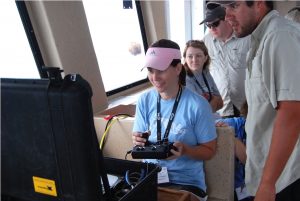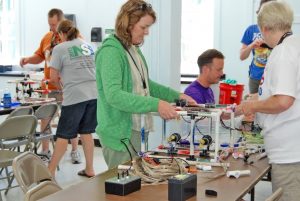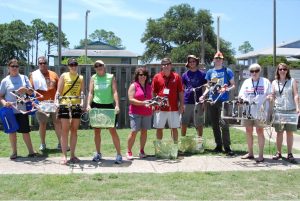Educators Dive into ROV Training and Emerge with Innovative Teaching Tools
– August 19, 2013
Ten high school teachers from Alabama and Florida are returning to their 2013-2014 science classes armed with new skills, materials, and inspiration.
In July, these educators attended a five-day workshop entitled Technology in Marine Science. They built and operated Remotely Operated Vehicles (ROVs) and, more importantly, learned how to use them as teaching tools in their classrooms. Throughout the coming year, the teachers will help their students design, build, and test their own ROVs and prepare them for spring competition.
The Dauphin Island Sea Lab (DISL) directs and hosts this and other teacher workshops as part of a larger education effort by the Deep Sea to Coast Connectivity in the Eastern Gulf of Mexico (Deep-C) research consortium. Their goal is to incorporate oil-spill related research – a topic of high public interest – into classrooms and assist teachers and students in understanding and using this relevant research and associated scientific and engineering concepts as well as a means to further Science, Technology, Engineering, and Mathematics (STEM) education.
The teachers learned how ROVs are used to explore, research, and work in ocean waters that are too deep or dangerous for direct human access. Madison High School engineering and physics teacher Greg Ennis commented, “The ocean floor is one of the last great unexplored frontiers on Earth. [ROVs] are a great opportunity to get students involved in an expanding STEM field.”
The training also covered a wide range of topics from wiring ROV motors to using real-time data in the classroom. The teachers then made and flew their own underwater robots and experimented with ways to help students understand some essential concepts behind ROV construction such as density and buoyancy. During this school year, teachers will guide their students through a similar hands-on process and prepare them for competitions that will test the application of science and design as well as students’ determination and team work.
“Our programs are intended to increase understanding and appreciation for science and the marine environment by directly involving participants in that environment with dynamic, hands-on activities,” says Dr. Tina Miller-Way, Chair of DISL Discovery Hall Programs. “Thus, in addition to building a ROV from the ground up and conducting classroom activities, the ROV [teacher] training included a field experience aboard the RV Alabama-Discovery where everyone got a chance to drive a research-quality ROV, use a bit of typical sampling gear, and see inshore and offshore trawls. ROVs are a great way to integrate ocean literacy and STEM efforts in schools. ”
Last year’s ROV events inspired two Tallahassee educators to organize a local competition between area high schools. Deep-C will sponsor the event, currently scheduled for December 2013.
“An exciting development is that we [DISL] are in the process of becoming a regional competition center for the internationally renowned MATE (Marine Advanced Technology Education) ROV competition,” says Dr. Miller-Way. “That means the winner of our spring 2013 contest will be eligible to compete at the international competition at Thunder Bay National Marine Sanctuary in June of 2014!”
Deep-C Coordinator Tracy Ippolito explains the importance of providing these experiences and tools to K-12 teachers and the motivation behind their consortium’s education and outreach mission, “As scientists and educators, we hope to instill in students some level of the wonder and awe we feel in discovery. And we accomplish that through innovative activities such as the Deep-C ROV competitions.”
For more information about educator resources and events sponsored by Deep-C or about the December 2013 Tallahassee ROV competition, please contact Amelia Vaughan, Deep-C Ocean Science Educator. Read more about the inaugural ROV student competition: Deep-C Technology Experiences Bring Science to Life for Students and First Annual Deep-C ROV Competition Showcases Students’ Talent and Ingenuity (includes a video).
This research was made possible in part by a grant from BP/The Gulf of Mexico Research Initiative (GoMRI) with the Deep Sea to Coast Connectivity in the Northern Gulf of Mexico consortium (Deep-C). The GoMRI is a 10-year, $500 million independent research program established by an agreement between BP and the Gulf of Mexico Alliance to study the effects of the Deepwater Horizon incident and the potential associated impact of this and similar incidents on the environment and public health.
© Copyright 2010- 2017 Gulf of Mexico Research Initiative (GoMRI) – All Rights Reserved. Redistribution is encouraged with acknowledgement to the Gulf of Mexico Research Initiative (GoMRI). Please credit images and/or videos as done in each article. Questions? Contact web-content editor Nilde “Maggie” Dannreuther, Northern Gulf Institute, Mississippi State University (maggied@ngi.msstate.edu).








